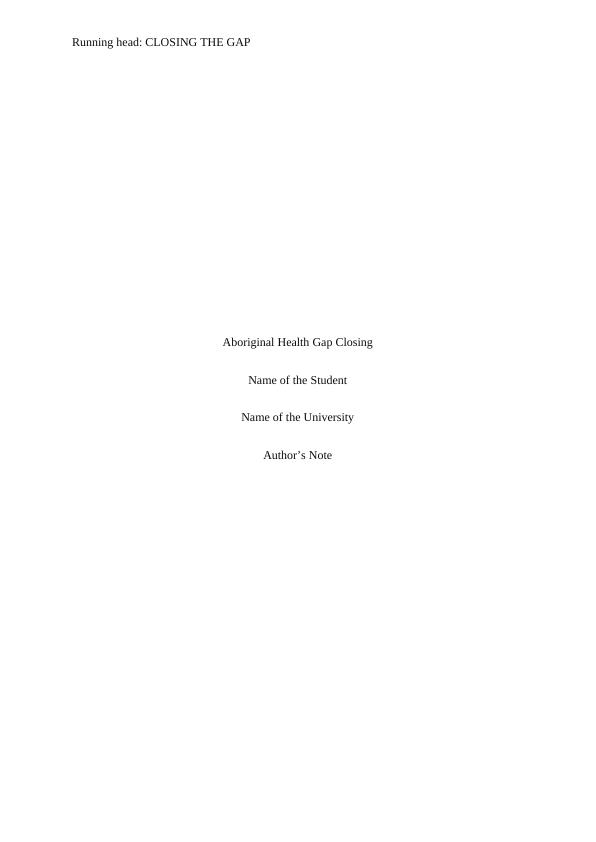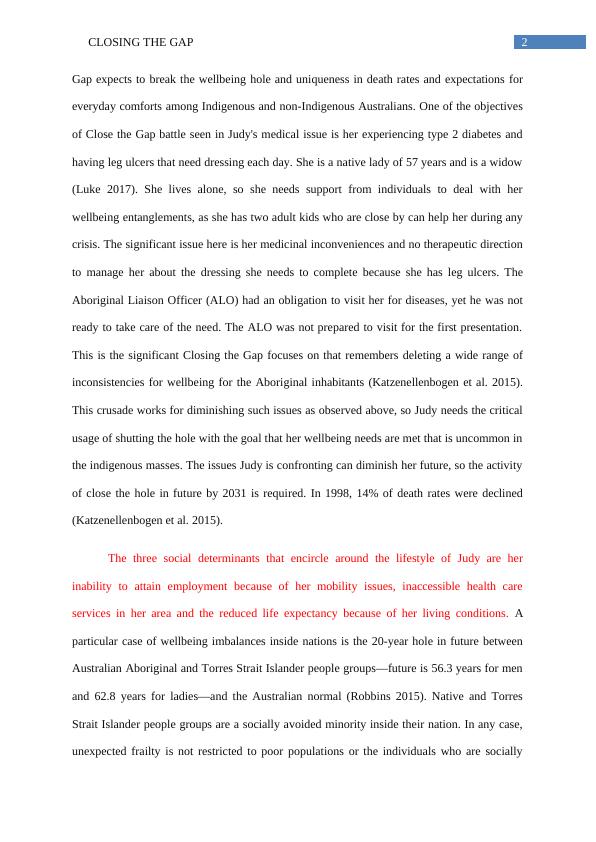Aboriginal Health Gap Closing
Added on 2022-09-01
9 Pages2583 Words35 Views
Running head: CLOSING THE GAP
Aboriginal Health Gap Closing
Name of the Student
Name of the University
Author’s Note
Aboriginal Health Gap Closing
Name of the Student
Name of the University
Author’s Note

1CLOSING THE GAP
Closing the Gap is an administration system that means to decrease difficulty among
Aboriginal and Torres Strait Islander individuals as for future, youngster mortality, and
access to early youth instruction, instructive accomplishment, and work results (Becker et al.
2017). It is a proper responsibility made by every Australian government to accomplish
Aboriginal and Torres Strait Islander wellbeing fairness inside 25 years (Trivedi et al. 2017).
Closing the Gap was created in light of the call of the Social equity report 2005 and the Close
the Gap social equity battle. Closing the Gap is planned for decreasing impediment among
Indigenous people groups as for youngster mortality, youth training, future and wellbeing
(Becker et al. 2017). Expanding the future is not just a medical problem, yet additionally,
human rights issue and are fundamental to the strengthening of Aboriginal and Torres Strait
Islander people groups (Marmot 2017). While Australia appreciates one of the most
noteworthy standard futures of any nation, the equivalent is not valid for some Indigenous
people group.
The Aboriginals in the nation have been for some time ignored on account of their
experience and origin (Love, Moore and Warburton 2017). Incessant diseases influence
Indigenous Australians at a lopsidedly more elevated level than non-indigenous Australians
(Fiedler 2018). Persistent infection happens at prior ages in Indigenous Australians,
representing 66% of the hole in mortality among Indigenous and non-Indigenous populations
and adding to early bleakness (Robbins 2015). In Australia, for instance, a country list of
access consolidates framework estimates, for example, the quantity of wellbeing
administrations inside a given territory and the general population supplier proportion, with
measures including the sort and level of distinguished wellbeing needs, separation to the
closest help and flexibility score (Baugh Littlejohns et al. 2019).
All in all, non-Indigenous Australians have more noteworthy chances to get better
lodging and human services and have a higher speed of work (Fisher et al. 2016). Closing the
Closing the Gap is an administration system that means to decrease difficulty among
Aboriginal and Torres Strait Islander individuals as for future, youngster mortality, and
access to early youth instruction, instructive accomplishment, and work results (Becker et al.
2017). It is a proper responsibility made by every Australian government to accomplish
Aboriginal and Torres Strait Islander wellbeing fairness inside 25 years (Trivedi et al. 2017).
Closing the Gap was created in light of the call of the Social equity report 2005 and the Close
the Gap social equity battle. Closing the Gap is planned for decreasing impediment among
Indigenous people groups as for youngster mortality, youth training, future and wellbeing
(Becker et al. 2017). Expanding the future is not just a medical problem, yet additionally,
human rights issue and are fundamental to the strengthening of Aboriginal and Torres Strait
Islander people groups (Marmot 2017). While Australia appreciates one of the most
noteworthy standard futures of any nation, the equivalent is not valid for some Indigenous
people group.
The Aboriginals in the nation have been for some time ignored on account of their
experience and origin (Love, Moore and Warburton 2017). Incessant diseases influence
Indigenous Australians at a lopsidedly more elevated level than non-indigenous Australians
(Fiedler 2018). Persistent infection happens at prior ages in Indigenous Australians,
representing 66% of the hole in mortality among Indigenous and non-Indigenous populations
and adding to early bleakness (Robbins 2015). In Australia, for instance, a country list of
access consolidates framework estimates, for example, the quantity of wellbeing
administrations inside a given territory and the general population supplier proportion, with
measures including the sort and level of distinguished wellbeing needs, separation to the
closest help and flexibility score (Baugh Littlejohns et al. 2019).
All in all, non-Indigenous Australians have more noteworthy chances to get better
lodging and human services and have a higher speed of work (Fisher et al. 2016). Closing the

2CLOSING THE GAP
Gap expects to break the wellbeing hole and uniqueness in death rates and expectations for
everyday comforts among Indigenous and non-Indigenous Australians. One of the objectives
of Close the Gap battle seen in Judy's medical issue is her experiencing type 2 diabetes and
having leg ulcers that need dressing each day. She is a native lady of 57 years and is a widow
(Luke 2017). She lives alone, so she needs support from individuals to deal with her
wellbeing entanglements, as she has two adult kids who are close by can help her during any
crisis. The significant issue here is her medicinal inconveniences and no therapeutic direction
to manage her about the dressing she needs to complete because she has leg ulcers. The
Aboriginal Liaison Officer (ALO) had an obligation to visit her for diseases, yet he was not
ready to take care of the need. The ALO was not prepared to visit for the first presentation.
This is the significant Closing the Gap focuses on that remembers deleting a wide range of
inconsistencies for wellbeing for the Aboriginal inhabitants (Katzenellenbogen et al. 2015).
This crusade works for diminishing such issues as observed above, so Judy needs the critical
usage of shutting the hole with the goal that her wellbeing needs are met that is uncommon in
the indigenous masses. The issues Judy is confronting can diminish her future, so the activity
of close the hole in future by 2031 is required. In 1998, 14% of death rates were declined
(Katzenellenbogen et al. 2015).
The three social determinants that encircle around the lifestyle of Judy are her
inability to attain employment because of her mobility issues, inaccessible health care
services in her area and the reduced life expectancy because of her living conditions. A
particular case of wellbeing imbalances inside nations is the 20-year hole in future between
Australian Aboriginal and Torres Strait Islander people groups—future is 56.3 years for men
and 62.8 years for ladies—and the Australian normal (Robbins 2015). Native and Torres
Strait Islander people groups are a socially avoided minority inside their nation. In any case,
unexpected frailty is not restricted to poor populations or the individuals who are socially
Gap expects to break the wellbeing hole and uniqueness in death rates and expectations for
everyday comforts among Indigenous and non-Indigenous Australians. One of the objectives
of Close the Gap battle seen in Judy's medical issue is her experiencing type 2 diabetes and
having leg ulcers that need dressing each day. She is a native lady of 57 years and is a widow
(Luke 2017). She lives alone, so she needs support from individuals to deal with her
wellbeing entanglements, as she has two adult kids who are close by can help her during any
crisis. The significant issue here is her medicinal inconveniences and no therapeutic direction
to manage her about the dressing she needs to complete because she has leg ulcers. The
Aboriginal Liaison Officer (ALO) had an obligation to visit her for diseases, yet he was not
ready to take care of the need. The ALO was not prepared to visit for the first presentation.
This is the significant Closing the Gap focuses on that remembers deleting a wide range of
inconsistencies for wellbeing for the Aboriginal inhabitants (Katzenellenbogen et al. 2015).
This crusade works for diminishing such issues as observed above, so Judy needs the critical
usage of shutting the hole with the goal that her wellbeing needs are met that is uncommon in
the indigenous masses. The issues Judy is confronting can diminish her future, so the activity
of close the hole in future by 2031 is required. In 1998, 14% of death rates were declined
(Katzenellenbogen et al. 2015).
The three social determinants that encircle around the lifestyle of Judy are her
inability to attain employment because of her mobility issues, inaccessible health care
services in her area and the reduced life expectancy because of her living conditions. A
particular case of wellbeing imbalances inside nations is the 20-year hole in future between
Australian Aboriginal and Torres Strait Islander people groups—future is 56.3 years for men
and 62.8 years for ladies—and the Australian normal (Robbins 2015). Native and Torres
Strait Islander people groups are a socially avoided minority inside their nation. In any case,
unexpected frailty is not restricted to poor populations or the individuals who are socially

End of preview
Want to access all the pages? Upload your documents or become a member.
Related Documents
Closing the Gap Strategy | Australialg...
|9
|2245
|22
Contemporary Indigenous Health and Wellbeinglg...
|10
|2616
|445
Closing the Gap Policy | Assignmentlg...
|8
|2134
|29
Depth Analysis Of Closing The Gaplg...
|8
|2359
|18
Contemporary Indigenous Health and Wellbeing - Assignmentlg...
|8
|2367
|270
Aboriginal Health Care System.lg...
|9
|2800
|24
